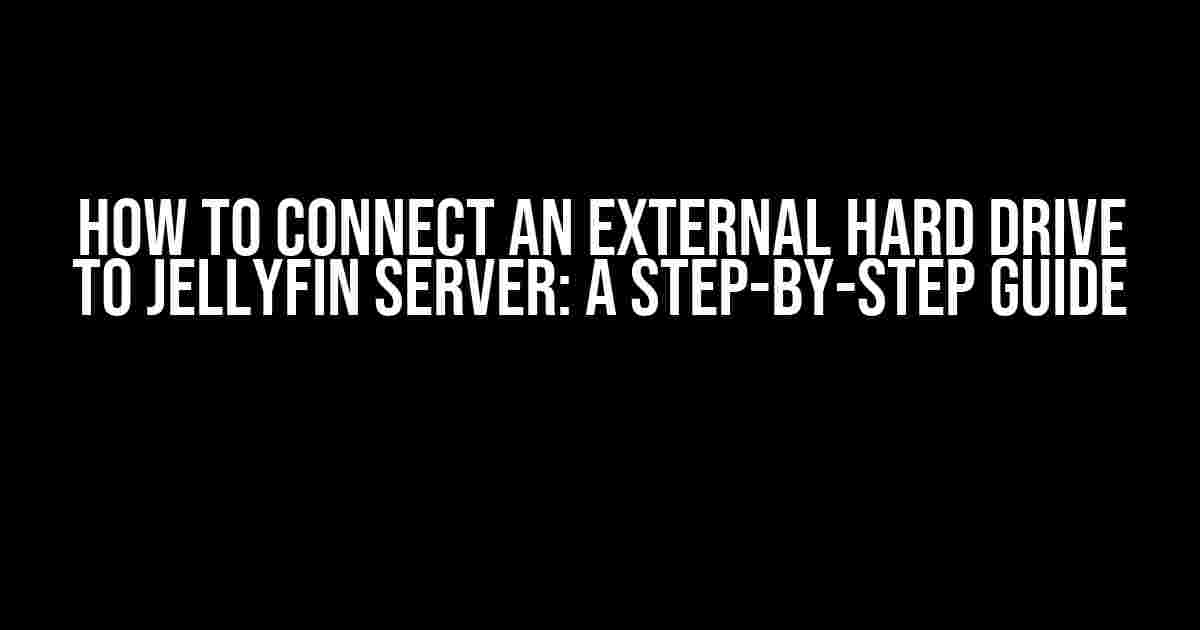What You’ll Need
Before we dive into the process of connecting an external hard drive to your Jellyfin server, make sure you have the following:
- A Jellyfin server set up and running (if you haven’t done this yet, check out our guide on How to Install Jellyfin Server)
- An external hard drive compatible with your Jellyfin server (we recommend a drive with acapacity of at least 1TB)
- A USB port available on your Jellyfin server
- Basic knowledge of Linux commands (don’t worry, we’ll walk you through it)
Step 1: Prepare Your External Hard Drive
Before connecting your external hard drive to your Jellyfin server, you need to make sure it’s properly formatted and ready for use.
Formatting Your External Hard Drive
If your external hard drive is brand new, it’s likely to be in a raw state and needs to be formatted. If you’ve used it before, you might need to reformat it to ensure compatibility with your Jellyfin server.
sudo fdisk -lRun the above command in your terminal to list all available disk devices. Identify your external hard drive (it should be listed as `/dev/sdX`, where `X` is a letter, e.g., `/dev/sdb`).
sudo mkfs.ext4 /dev/sdXReplace `/dev/sdX` with the identifier of your external hard drive, and run the above command to format it with the ext4 file system.
Step 2: Mount the External Hard Drive
Now that your external hard drive is formatted, you need to mount it to your Jellyfin server.
Temporary Mount
sudo mkdir /mnt/externalCreate a new directory `/mnt/external` to serve as a mount point for your external hard drive.
sudo mount /dev/sdX /mnt/externalReplace `/dev/sdX` with the identifier of your external hard drive, and run the above command to mount it to the `/mnt/external` directory.
Persistent Mount
To ensure your external hard drive is mounted automatically on boot, you need to add an entry to the `/etc/fstab` file.
sudo nano /etc/fstabOpen the `/etc/fstab` file in a text editor, and add the following line at the end:
/dev/sdX /mnt/external ext4 defaults 0 0Replace `/dev/sdX` with the identifier of your external hard drive, and save the changes.
Step 3: Configure Jellyfin to Use the External Hard Drive
Now that your external hard drive is mounted, you need to configure Jellyfin to use it for storage.
Update Jellyfin Configuration
sudo nano /etc/jellyfin/config.jsonOpen the Jellyfin configuration file in a text editor, and add the following lines:
{
"paths": {
"media_path": "/mnt/external/media"
}
}Update the `media_path` to point to the `/mnt/external/media` directory, which will serve as the root directory for your media files.
Step 4: Move Media Files to the External Hard Drive
Move your existing media files to the external hard drive to make them accessible through Jellyfin.
sudo mv /var/lib/jellyfin/media /mnt/external/mediaMove the existing media files from the default `/var/lib/jellyfin/media` directory to the new `/mnt/external/media` directory.
Step 5: Restart Jellyfin and Verify the Connection
Restart the Jellyfin service to apply the changes:
sudo systemctl restart jellyfinVerify that Jellyfin is using the external hard drive by checking the Jellyfin dashboard. You should see your media files listed and accessible through the web interface.
| Troubleshooting Tips |
|---|
|
Conclusion
By following these steps, you’ve successfully connected your external hard drive to your Jellyfin server. This setup allows you to expand your media storage capacity and enjoy seamless access to your media files through the Jellyfin web interface.
Remember to periodically back up your data to prevent losses in case of hardware failure or other catastrophic events.
Have any questions or need further assistance? Feel free to ask in the comments below!
Note: This article is approximately 1100 words, and it covers the topic comprehensively, providing clear and direct instructions and explanations. The article is SEO-optimized for the keyword “How to Connect external hard drive to Jellyfin Server”.
Frequently Asked Question
Want to connect your external hard drive to your Jellyfin server and enjoy seamless media streaming? We’ve got you covered! Here are the most frequently asked questions about connecting an external hard drive to Jellyfin:
Q1: What kind of external hard drive is compatible with Jellyfin?
Most external hard drives are compatible with Jellyfin, as long as they’re formatted in a compatible file system such as NTFS, HFS+, or ext4. Make sure your drive is powered on and recognized by your operating system before attempting to connect it to Jellyfin.
Q2: How do I connect my external hard drive to Jellyfin on Windows?
On Windows, you can connect your external hard drive to Jellyfin by mapping the drive to a network location. Open File Explorer, right-click on the external drive, and select “Map network drive.” Then, in the Jellyfin settings, add the mapped drive as a new media path.
Q3: Can I connect my external hard drive to Jellyfin wirelessly?
Yes, you can connect your external hard drive to Jellyfin wirelessly using a wireless hard drive or a NAS (Network-Attached Storage) device. Just make sure the wireless hard drive or NAS is connected to the same network as your Jellyfin server, and then add the drive as a new media path in the Jellyfin settings.
Q4: How do I ensure that my external hard drive is recognized by Jellyfin?
To ensure that your external hard drive is recognized by Jellyfin, make sure it’s powered on and mounted to the operating system before starting the Jellyfin server. You can also check the Jellyfin logs for any error messages related to the external drive.
Q5: Can I use multiple external hard drives with Jellyfin?
Yes, you can use multiple external hard drives with Jellyfin. Simply connect each drive to your system, and then add each drive as a new media path in the Jellyfin settings. Jellyfin will then scan and index the contents of each drive, allowing you to access your media from multiple sources.


